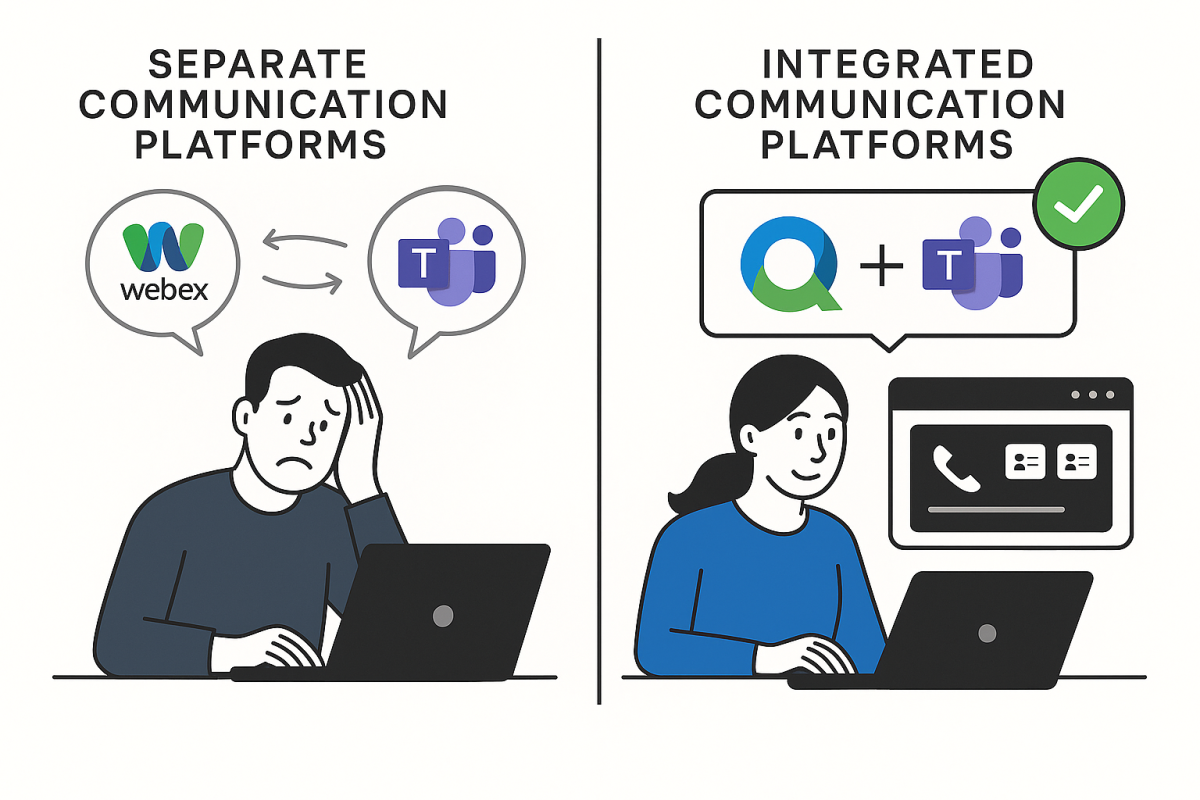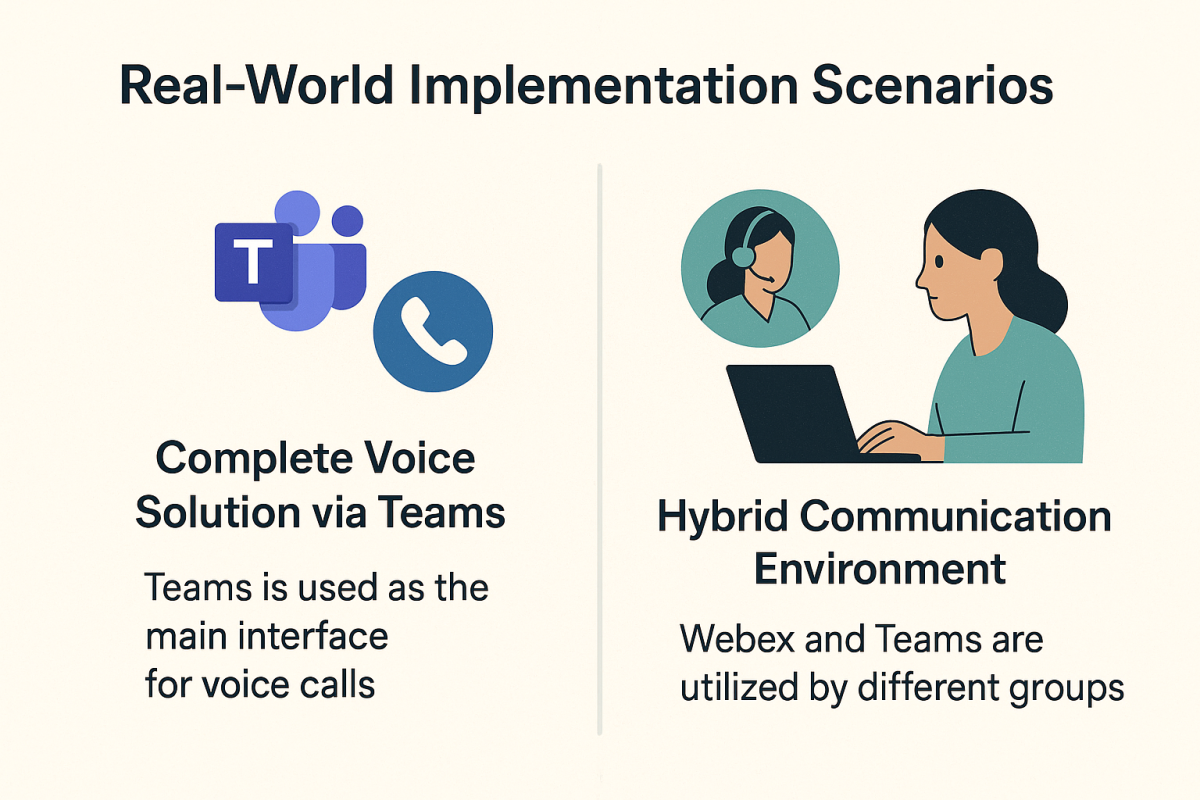Businesses increasingly find themselves navigating multiple communication platforms as they seek to connect distributed teams. The integration of Cisco Webex and Microsoft Teams offers organizations a strategic solution that combines Webex's powerful voice capabilities with Teams' collaboration features, creating a unified system that enhances productivity without requiring costly infrastructure changes.
This integration addresses a fundamental challenge facing modern enterprises: how to standardize on Microsoft Teams for collaboration while maintaining investments in Cisco voice technology. Rather than forcing an either/or decision, integration enables businesses to create a seamless environment where both platforms complement each other, allowing users to access calling features directly within the Teams interface while preserving the enterprise-grade voice capabilities they depend on.
Understanding the Business Need for Integration
Modern businesses face a common challenge: they've invested in multiple communication technologies that don't naturally work together. Many organizations find themselves with Microsoft Teams for messaging and collaboration alongside Cisco's voice infrastructure for calling capabilities. Without integration, this creates workflow disruptions, reduces productivity, and increases IT management complexity.
Integration between Webex and Teams addresses these fundamental business needs by providing a unified experience. Rather than forcing users to switch between applications or requiring businesses to completely replace existing infrastructure, integration creates a seamless environment where both platforms complement each other.
This approach resonates with organizations that have invested significantly in their calling infrastructure but want to standardize on Microsoft Teams as their primary collaboration tool. By integrating these platforms, businesses can protect their investments while adapting to changing workplace preferences.
Key Benefits of Webex and Teams Integration
The strategic advantages of integrating Webex and Teams extend beyond simple convenience, delivering tangible business outcomes across multiple dimensions.

Enhanced User Experience
When implemented effectively, the integration creates a seamless experience where users can access Cisco calling functionality directly within the Microsoft Teams interface. This eliminates the need to switch between applications, reducing friction and cognitive load. Users can make and receive calls, access voicemail, view call history, and utilize advanced calling features—all from within Teams.
The integration supports both audio and video calling capabilities, ensuring that teams have access to the full spectrum of communication options without compromising quality. Additionally, presence status synchronization between platforms keeps team members informed about availability across the integrated environment.
Maximized Existing Investments
For organizations with established Cisco voice infrastructure, integration provides a path to embrace Microsoft Teams without abandoning previous investments. This hybrid approach allows businesses to leverage the enterprise-grade calling features of Cisco's platform while standardizing on Teams for chat and collaboration.
The integration works with various Cisco calling platforms, including Webex Calling, Unified Communications Manager (CUCM), and Dedicated Instance deployments. This flexibility ensures that businesses can adapt the integration to their specific infrastructure requirements rather than conforming to a rigid, one-size-fits-all approach.

Simplified Administration
IT departments benefit significantly from the consolidated management capabilities that integration provides. Rather than maintaining parallel systems with duplicate processes, administrators can manage a unified communications environment more efficiently.
The integration enables centralized provisioning, monitoring, and troubleshooting, reducing administrative overhead and allowing IT teams to focus on strategic initiatives rather than routine maintenance. Additionally, consolidated billing streamlines financial management, providing clearer visibility into communication costs.
Implementation Considerations
While the benefits are compelling, successful integration requires careful planning and consideration of several key factors.
Technical Requirements
Implementing Webex and Teams integration involves specific technical prerequisites. Organizations need appropriate licensing for both platforms and must ensure their network infrastructure can support the integrated communication flows. Authentication mechanisms, particularly Single Sign-On (SSO), play a crucial role in creating a seamless user experience across the integrated environment.
Network bandwidth and quality of service configurations require assessment to ensure optimal performance, especially for voice and video communication. Additionally, organizations should review their existing telephony architecture to determine the most appropriate integration method for their specific requirements.
User Adoption Strategy
Even the most technically sound integration will fail without effective user adoption. Organizations should develop a comprehensive change management plan that includes clear communication about the benefits of integration, thorough training on new workflows, and ongoing support during the transition period.
Creating champions within different departments can help accelerate adoption by providing peer guidance and encouragement. Additionally, gathering feedback during the initial deployment phase allows organizations to address pain points quickly and refine the implementation based on real-world usage patterns.
Real-World Implementation Scenarios
Different organizations implement Webex and Teams integration in various ways depending on their specific needs and existing infrastructure.
Complete Voice Solution via Teams
Many businesses choose to implement a full Webex calling solution accessible through Microsoft Teams. In this scenario, Teams serves as the primary user interface for all communication, while Webex provides the underlying voice infrastructure. Users make and receive calls, check voicemail, and access call history directly from the Teams interface, with all voice traffic handled by the Webex platform.
This approach is particularly beneficial for organizations that have standardized on Microsoft Teams for collaboration but want to leverage Cisco's enterprise-grade voice capabilities. Users enjoy a consistent experience while IT maintains control over the voice infrastructure.
Hybrid Communication Environment
Some organizations implement a hybrid approach where certain departments or functions primarily use Webex while others standardize on Teams. The integration allows for seamless communication between these groups without requiring users to switch platforms or maintain multiple accounts.
This scenario often emerges in environments where specific departments have specialized communication needs that align better with one platform's capabilities. For example, a contact center might leverage Webex's advanced call handling features while general office staff use Teams for day-to-day collaboration.
Future Trends in Unified Communications
As integration capabilities continue to evolve, several trends are shaping the future of unified communications in the enterprise. The development of more sophisticated APIs and connectors will further enhance interoperability between platforms, allowing for deeper integration and more seamless user experiences.
Artificial intelligence is playing an increasingly important role in unified communications, with features like automatic transcription, real-time translation, and intelligent meeting assistants becoming more prevalent. These capabilities will likely extend across integrated environments, providing consistent AI-enhanced experiences regardless of the underlying platform.
The shift toward cloud-based communication infrastructures continues to accelerate, with organizations increasingly moving away from on-premises solutions. This trend facilitates more flexible integration options and enables faster adoption of new capabilities as they become available.
Making the Strategic Choice
Integrating Webex and Teams represents a strategic decision that balances immediate practical needs with long-term communication goals. By unifying these platforms, businesses can create a cohesive communication environment that enhances productivity, simplifies management, and maximizes return on existing investments.
The choice to integrate rather than replace demonstrates a pragmatic approach to digital transformation—one that acknowledges the value of established systems while embracing new collaboration tools. For organizations navigating the complex landscape of enterprise communications, Pure IP's Enterprise Voice provides the expertise and technology needed to implement successful integrations that deliver real business value. Contact us to learn more.





